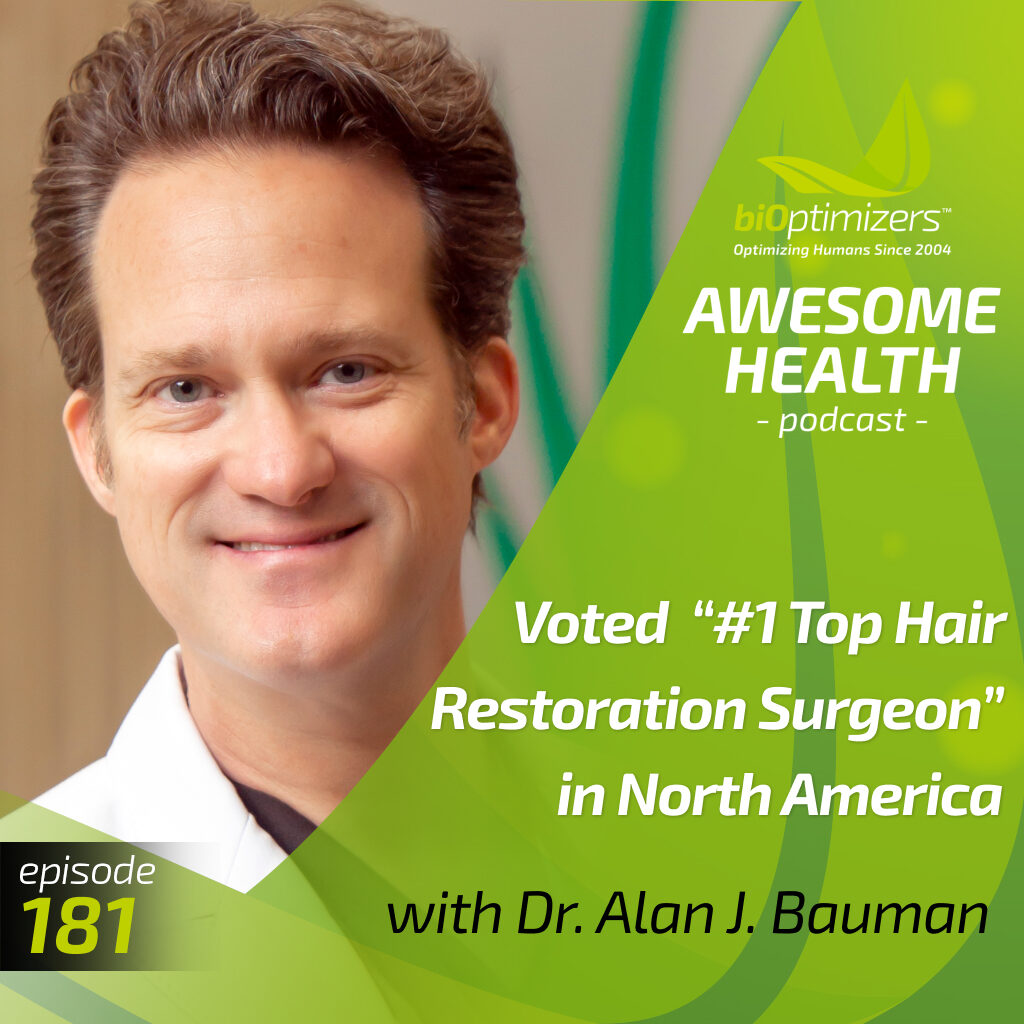181: Dr. Alan J. Bauman: Voted “#1 Top Hair Restoration Surgeon” in North America

Our guest, Dr. Alan J. Bauman, takes a deep dive into the causes of hair loss in men and women and describes a number of treatment options. Dr. Bauman is a full-time board-certified hair restoration physician who has treated over 30,000 patients and performed more than 10,000 hair transplant procedures since starting his practice at Bauman Medical, located in Boca Raton, FL in 1997.
Recognized by Forbes as one of “10 CEOs Transforming Healthcare in America,” Dr. Bauman is known for pioneering numerous technologies in the field of hair restoration including minimally-invasive FUE Follicular Unit Extraction, VIP|FUE™ No-Shave Hair Transplant, Low-Level Laser Therapy, PRP Platelet Rich Plasma, PDOgro™, Eyelash Transplants and others.
He is a frequently invited faculty member and guest expert at numerous international scientific meetings and live surgery workshops and has been featured in hundreds of news stories in the media. You may have seen him on NBC Today, CBS Early Show, ABC Good Morning America, CNN, The Doctors, Spencer Kobren’s The Bald Truth, Bulletproof Radio with Dave Asprey or featured in Men’s Health, GQ, Vogue, Harper’s Bazaar, The New York Times, Oprah Magazine and many more.
In this podcast we cover:
- Psychological impact of hair loss: aging, anxiety depression.
- “Time is follicles.” Hair loss doesn’t get better without treatment.
- 5,000-year history: Egyptian pigeon droppings and lizard skin.
- Evolution of FDA-approved treatments and transplants.
- Therapeutic and diagnostic interventions: AI-powered microscopes and DNA.
- How are diagnostics and treatments managed at Bauman Medical?
- Wade gets a live hair consultation!
Watching this podcast, you’ll be quickly taken in by Dr. Bauman’s charisma, knowledge and talent. He inspires us all to “feel great every day” and offers life-changing procedures he’s perfected over 25 years for those who want to roll back hair loss and capture the vitality of their younger days.
A healthy head of hair doesn’t always require medical interventions. Dr. Bauman also highlights the importance of stress reduction techniques, good sleep, healthy dieting and keeping the body optimized to improve hair quality.
As is so often the case in life, a random discussion (with a hair transplant patient) transformed Dr. Bauman from a general surgeon to a medical hair restoration physician. As Dr. Bauman tells it, “The one thing that really stuck with me from that first conversation was how it changed his life and I’ll never forget his description of how he changed personally and professionally.”
Hair loss, what’s the big deal?
“It’s a sensitive topic for a lot of people. They’re embarrassed about it, they want to talk about it, there’s a vanity issue and there’s all these different things about it.”
“Appearance wise, they want to look good and feel great. That’s the fun part about having a practice like mine. I’ve been enjoying it like that, you know for 25 years.”
“They see it [hair loss] as a sign of their youth slipping away.”
What can I expect if I choose treatment?
Diagnosis, treatment and post-care are the cornerstones of the service provided at Bauman Medical and are tailored to each client’s specific condition and expectations.
“And so we have to have the first, most important thing, which is a good plan.”
“The first thing we talk about always, what are the appropriate expectations for what the procedure can provide?”
“The most common risk is that a person has a procedure, but they don’t continue on with medical therapy or they fall off the wagon.”
“That they must continue, whether it be a topical medication, oral medication, nutritional, nutraceutical or using the laser that they invested in. And that’s really been the secret to our success with our patients is that consistent follow up and that kind of team approach.”
How goes Wade’s consult?
Dr. Bauman typically does consults in the office or via Zoom. Patients are required to complete a lengthy questionnaire regarding lifestyle, health conditions and expectations. Further, genetic testing is recommended to provide an optimized treatment plan—personalized, precision medicine.
Following are excerpts from a 20-minute “consult” without the detailed background information in which Wade seeks advice for his thinning hair.
DR: “Tell me a little bit about your hair loss situation and maybe what you’re seeing in the mirror and how it looks to you when you look at your hair and when you first became aware of some hair changes?
WL: “Maybe in my late 20s I just started to notice like over here on the sides, particularly. It would just start to go back a little bit more. Nothing that was alarming, but something I do recall noticing it’s kind of like when you get your first wrinkle. A percentage of loss is happening, each year, and now I have very fine hair, as well as existing blonde and very light.”
WL: “So that also amplifies it in certain lighting when I’m on lights and things like that, so you know that that light shines right through my hair. I’d like it to be a little thicker so I don’t go full Kojak too soon.
DR: “Sure, and as mentioned before you do have some family hair loss on your dad’s side. So we know hair loss that is genetic male pattern baldness does come from the families, mom-side or dad-side or both and it can skip generations and siblings.”
DR: “The good news about that crown area is that we can definitely protect and restore that area, probably with non-invasive therapies. But if you’re looking to change the way your hairline looks then obviously we would need to do something more aggressive.”
WL: “Well, I think, if I had a magic wand, I would just kind of return it back to maybe where it was when I was in my early 20s. I’d have no receding parts here.”
DR: “Teenager hairline is not going to look normal and natural as you continue to age, and so we need to talk about an age appropriate hairline, which is going to have a little bit of a recession to it.”
DR: “But the cool thing about this kind of technology is that even at four days out from the procedure you can do tennis and golf and lift weights, you can be at the gym sweating sauna. It takes about four to five months for those hairs to start to kick in and grow.”
Stay tuned for more news about Wade’s detailed treatment plan.
As Wade notes, everybody in the biohacking community is talking about health and vibrancy and living long and living strong. But there’s also a cosmetic side. We typically start each day looking in the mirror.
“Why have a Ferrari, with a bad paint job when you can have it with a nice shiny clear coat? I think hair is one of those things that really makes someone look vibrant, young and vital.”
“I want to look as good as I feel. I’ve been taking care of myself… I’m doing the biohacking thing… I’m on the journey… I’m in the tribe.”
More references:





